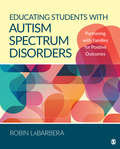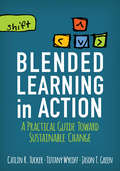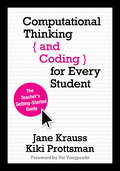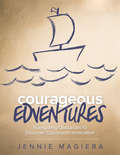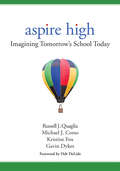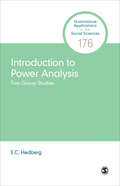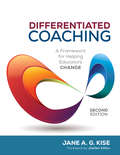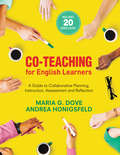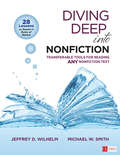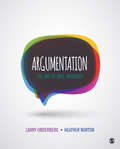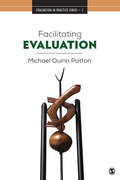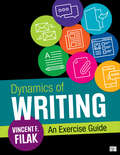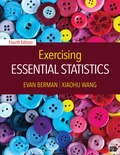- Table View
- List View
Educating Students with Autism Spectrum Disorders: Partnering with Families for Positive Outcomes
by Robin L. LaBarberaEducating Students with Autism Spectrum Disorders: Partnering with Families for Positive Outcomes focuses on practical strategies for educating children with autism spectrum disorders in the classroom. Additional features describe how to partner with families in the implementation of many of the strategies, giving voice to parents, based on recent quantitative and qualitative research. Case studies developed from real interviews with parents and educators open each chapter, and the book focuses on what "works" and what "does not work" in their collaborative experiences.
Educating Students with Autism Spectrum Disorders: Partnering with Families for Positive Outcomes
by Robin L. LaBarberaEducating Students with Autism Spectrum Disorders: Partnering with Families for Positive Outcomes focuses on practical strategies for educating children with autism spectrum disorders in the classroom. Additional features describe how to partner with families in the implementation of many of the strategies, giving voice to parents, based on recent quantitative and qualitative research. Case studies developed from real interviews with parents and educators open each chapter, and the book focuses on what "works" and what "does not work" in their collaborative experiences.
Blended Learning in Action: A Practical Guide Toward Sustainable Change (Corwin Teaching Essentials)
by Catlin R. Tucker Tiffany Wycoff Jason T. GreenShift to blended learning to transform education Blended learning has the power to reinvent education, but transitioning to a blended model is challenging. Blended learning requires a fundamentally new approach to learning as well as a new skillset for both teachers and school leaders. Loaded with research, examples, and resources, Blended Learning in Action demonstrates the advantages a blended model has over traditional instruction when technology is used to engage students both inside the classroom and online. Readers will find: Breakdowns of the most effective classroom setups for blended learning Guidelines to build a blended learning toolbox of tech and resources Tips for leaders Ideas for personalizing and differentiating instruction using technology Strategies for managing devices in classrooms and schools Study questions to facilitate professional development and deeper learning Written with system-wide transformation in mind, this is the resource teachers and leaders need to help them shift to a blended learning model and transform education for today′s learning environment. "The time for blended learning is now and the place is ALL classrooms throughout the country. This book provides educators with essential information and practices that will prepare students for the 21st Century." Kim Weber, 4th Grade Teacher Mandell School, New York, NY "This book is different. It is deeper and more serious about creating the change students deserve than most others. The fact that each and every chapter starts out with a student′s perspective confirms that it is built on a vital pedagogical foundation." Brad Gustafson, Principal and Author of Renegade Leadership Greenwood Elementary, Wayzata, MN
Blended Learning in Action: A Practical Guide Toward Sustainable Change (Corwin Teaching Essentials)
by Catlin R. Tucker Tiffany Wycoff Jason T. GreenShift to blended learning to transform education Blended learning has the power to reinvent education, but transitioning to a blended model is challenging. Blended learning requires a fundamentally new approach to learning as well as a new skillset for both teachers and school leaders. Loaded with research, examples, and resources, Blended Learning in Action demonstrates the advantages a blended model has over traditional instruction when technology is used to engage students both inside the classroom and online. Readers will find: Breakdowns of the most effective classroom setups for blended learning Guidelines to build a blended learning toolbox of tech and resources Tips for leaders Ideas for personalizing and differentiating instruction using technology Strategies for managing devices in classrooms and schools Study questions to facilitate professional development and deeper learning Written with system-wide transformation in mind, this is the resource teachers and leaders need to help them shift to a blended learning model and transform education for today′s learning environment. "The time for blended learning is now and the place is ALL classrooms throughout the country. This book provides educators with essential information and practices that will prepare students for the 21st Century." Kim Weber, 4th Grade Teacher Mandell School, New York, NY "This book is different. It is deeper and more serious about creating the change students deserve than most others. The fact that each and every chapter starts out with a student′s perspective confirms that it is built on a vital pedagogical foundation." Brad Gustafson, Principal and Author of Renegade Leadership Greenwood Elementary, Wayzata, MN
Computational Thinking and Coding for Every Student: The Teacher’s Getting-Started Guide
by Jane Krauss Kiki ProttsmanEmpower tomorrow’s tech innovators Our students are avid users and consumers of technology. Isn’t it time that they see themselves as the next technological innovators, too? Computational Thinking and Coding for Every Student is the beginner’s guide for K-12 educators who want to learn to integrate the basics of computer science into their curriculum. Readers will find Practical strategies for teaching computational thinking and the beginning steps to introduce coding at any grade level, across disciplines, and during out-of-school time Instruction-ready lessons and activities for every grade Specific guidance for designing a learning pathway for elementary, middle, or high school students Justification for making coding and computer science accessible to all A glossary with definitions of key computer science terms, a discussion guide with tips for making the most of the book, and companion website with videos, activities, and other resources Momentum for computer science education is growing as educators and parents realize how fundamental computing has become for the jobs of the future. This book is for educators who see all of their students as creative thinkers and active contributors to tomorrow’s innovations. "Kiki Prottsman and Jane Krauss have been at the forefront of the rising popularity of computer science and are experts in the issues that the field faces, such as equity and diversity. In this book, they’ve condensed years of research and practitioner experience into an easy to read narrative about what computer science is, why it is important, and how to teach it to a variety of audiences. Their ideas aren’t just good, they are research-based and have been in practice in thousands of classrooms…So to the hundreds and thousands of teachers who are considering, learning, or actively teaching computer science—this book is well worth your time." Pat Yongpradit Chief Academic Officer, Code.org
Computational Thinking and Coding for Every Student: The Teacher’s Getting-Started Guide
by Jane Krauss Kiki ProttsmanEmpower tomorrow’s tech innovators Our students are avid users and consumers of technology. Isn’t it time that they see themselves as the next technological innovators, too? Computational Thinking and Coding for Every Student is the beginner’s guide for K-12 educators who want to learn to integrate the basics of computer science into their curriculum. Readers will find Practical strategies for teaching computational thinking and the beginning steps to introduce coding at any grade level, across disciplines, and during out-of-school time Instruction-ready lessons and activities for every grade Specific guidance for designing a learning pathway for elementary, middle, or high school students Justification for making coding and computer science accessible to all A glossary with definitions of key computer science terms, a discussion guide with tips for making the most of the book, and companion website with videos, activities, and other resources Momentum for computer science education is growing as educators and parents realize how fundamental computing has become for the jobs of the future. This book is for educators who see all of their students as creative thinkers and active contributors to tomorrow’s innovations. "Kiki Prottsman and Jane Krauss have been at the forefront of the rising popularity of computer science and are experts in the issues that the field faces, such as equity and diversity. In this book, they’ve condensed years of research and practitioner experience into an easy to read narrative about what computer science is, why it is important, and how to teach it to a variety of audiences. Their ideas aren’t just good, they are research-based and have been in practice in thousands of classrooms…So to the hundreds and thousands of teachers who are considering, learning, or actively teaching computer science—this book is well worth your time." Pat Yongpradit Chief Academic Officer, Code.org
Courageous Edventures: Navigating Obstacles to Discover Classroom Innovation (Corwin Teaching Essentials)
by Jennie MagieraChart a course to innovation using educational technology Let’s go on an edventure! Do you want to innovate and take risks in your teaching? Looking for ways to troubleshoot common classroom challenges? Whatever obstacles you and your students face can turn into edventures, and this book will show you how to navigate them with grace, humor, and grit. Jennie Magiera charts a course for you to discover your own version of innovation, using the limitless possibilities of educational technology. You will learn: How to create your own Teacher-IEP (Innovation Exploration Plan) Keys to problem-based innovation (PBI) Strategies and solutions for tackling common classroom problems Methods for putting learning into the hands of students How to find innovation in everyday places Packed with real-world, immediately applicable solutions to the problems teachers face in their classrooms every day,Courageous Edventures shows how technology can be a fun and easy tool to improve classroom management and student learning! "Magiera leads people on a journey with some great ideas to get started in the classroom right now, or the inspiration to find your own way, leading to innovative ideas for learning and teaching." George Couros, Author of The Innovator′s Mindset and Innovative Teaching, Learning, and Leadership Consultant "This book does a superb job of providing practical ideas and strategies on how to actually implement innovative practices in today′s classroom. Her knowledge and experience as a change agent further strengthen the techniques presented and will help educators truly envision what′s possible in classrooms today." Eric Sheninger, Corwin Author and Senior Fellow International Center for Leadership in Education
Courageous Edventures: Navigating Obstacles to Discover Classroom Innovation (Corwin Teaching Essentials)
by Jennie MagieraChart a course to innovation using educational technology Let’s go on an edventure! Do you want to innovate and take risks in your teaching? Looking for ways to troubleshoot common classroom challenges? Whatever obstacles you and your students face can turn into edventures, and this book will show you how to navigate them with grace, humor, and grit. Jennie Magiera charts a course for you to discover your own version of innovation, using the limitless possibilities of educational technology. You will learn: How to create your own Teacher-IEP (Innovation Exploration Plan) Keys to problem-based innovation (PBI) Strategies and solutions for tackling common classroom problems Methods for putting learning into the hands of students How to find innovation in everyday places Packed with real-world, immediately applicable solutions to the problems teachers face in their classrooms every day,Courageous Edventures shows how technology can be a fun and easy tool to improve classroom management and student learning! "Magiera leads people on a journey with some great ideas to get started in the classroom right now, or the inspiration to find your own way, leading to innovative ideas for learning and teaching." George Couros, Author of The Innovator′s Mindset and Innovative Teaching, Learning, and Leadership Consultant "This book does a superb job of providing practical ideas and strategies on how to actually implement innovative practices in today′s classroom. Her knowledge and experience as a change agent further strengthen the techniques presented and will help educators truly envision what′s possible in classrooms today." Eric Sheninger, Corwin Author and Senior Fellow International Center for Leadership in Education
Aspire High: Imagining Tomorrow′s School Today
by Russell J. Quaglia Michael J. Corso Kristine Fox Gavin A. DykesThe ideal school is closer than you think. Welcome to Aspire High! The world’s best high school may be a dream, but it’s not out of reach. It’s a model drawn from research, observations, focus groups, and interviews, and each aspect of its success exists in a real school today. In this book, you’ll discover what makes Aspire High’s culture of aspiration work. Whether you’re a policymaker or district leader who can build a school from the ground up or an educator aiming for incremental change, you’ll find your next steps, including: A whole new way to work with all stakeholders Research and action for best practices, from physical layout to curriculum Principles for designing practices that encourage student aspirations Messages from thought leaders inside and outside the field of education Aspirational culture is good for the whole school community—and beyond. Make your school a dynamic place that promotes aspirations and meaningful learning for all.
Aspire High: Imagining Tomorrow′s School Today
by Russell J. Quaglia Michael J. Corso Kristine Fox Gavin A. DykesThe ideal school is closer than you think. Welcome to Aspire High! The world’s best high school may be a dream, but it’s not out of reach. It’s a model drawn from research, observations, focus groups, and interviews, and each aspect of its success exists in a real school today. In this book, you’ll discover what makes Aspire High’s culture of aspiration work. Whether you’re a policymaker or district leader who can build a school from the ground up or an educator aiming for incremental change, you’ll find your next steps, including: A whole new way to work with all stakeholders Research and action for best practices, from physical layout to curriculum Principles for designing practices that encourage student aspirations Messages from thought leaders inside and outside the field of education Aspirational culture is good for the whole school community—and beyond. Make your school a dynamic place that promotes aspirations and meaningful learning for all.
Introduction to Power Analysis: Two-Group Studies (Quantitative Applications in the Social Sciences #176)
by E. C. HedbergIntroduction to Power Analysis: Two-Group Studies provides readers with the background, examples, and explanation they need to read technical papers and materials that include complex power analyses. This clear and accessible guide explains the components of test statistics and their sampling distributions, and author Eric Hedberg walks the reader through the simple and complex considerations of this research question. Filled with graphics and examples, the reader is taken on a tour of power analyses from covariates to clusters, seeing how the complicated task of comparing two groups, and the power analysis, can be made easy.
Introduction to Power Analysis: Two-Group Studies (Quantitative Applications in the Social Sciences #176)
by E. C. HedbergIntroduction to Power Analysis: Two-Group Studies provides readers with the background, examples, and explanation they need to read technical papers and materials that include complex power analyses. This clear and accessible guide explains the components of test statistics and their sampling distributions, and author Eric Hedberg walks the reader through the simple and complex considerations of this research question. Filled with graphics and examples, the reader is taken on a tour of power analyses from covariates to clusters, seeing how the complicated task of comparing two groups, and the power analysis, can be made easy.
Differentiated Coaching: A Framework for Helping Educators Change
by Jane A. KiseDifferentiate your coaching practice to meet the needs of every teacher! Jane Kise takes you on a journey into differentiated coaching with a strength-based framework for understanding, appreciating, and working with people who may think differently from you. Through an online self-assessment tool, you will discover how your strengths and beliefs influence your coaching practice. Through examples, case studies, and reflection exercises, you will understand how to: Tailor your coaching practices to meet the needs of each educator Increase teacher willingness to implement new skills in their classrooms Anticipate patterns of resistance and adjust both the content and delivery of professional development
Differentiated Coaching: A Framework for Helping Educators Change
by Jane A. KiseDifferentiate your coaching practice to meet the needs of every teacher! Jane Kise takes you on a journey into differentiated coaching with a strength-based framework for understanding, appreciating, and working with people who may think differently from you. Through an online self-assessment tool, you will discover how your strengths and beliefs influence your coaching practice. Through examples, case studies, and reflection exercises, you will understand how to: Tailor your coaching practices to meet the needs of each educator Increase teacher willingness to implement new skills in their classrooms Anticipate patterns of resistance and adjust both the content and delivery of professional development
Co-Teaching for English Learners: A Guide to Collaborative Planning, Instruction, Assessment, and Reflection
by Maria G. Dove Andrea Honigsfeld"Dove and Honigsfeld′s new book arrives at the perfect time as an increasing number of schools move to a collaborative instructional model and are searching for guidance. The authors not only tell us how to effectively collaborate and co-teach to benefit English learners, they actually show us what each component of the collaborative instructional cycle looks and feels like, complemented by innovative video and web content." —DIANE STAEHR FENNER, Coauthor of Unlocking ELs’ Potential and President of SupportEd Because teacher collaboration isn’t an option, it’s a MUST! The proof is borne out by any assessment: our non-native speakers learn faster and achieve more when general ed teachers and EL specialists co-plan and co-deliver instruction in the very same classroom. That’s why you’ll want to put Co-Teaching for English Learners at the top of your reading list. Step by step, EL authorities Maria Dove and Andrea Honigsfeld walk you through the entire collaborative instruction cycle, along with seven potential classroom configurations from which to choose. Whether you’re new to co-teaching or just see room for improvement in your practice, this practical handbook delivers every technique and tool you need to make the most of your collaboration, including video footage of co-teaching in action. Inside you’ll find: • In-depth profiles of the seven models, with detailed descriptions and analyses • A review of advantages and challenges of each model’s implementation • Clear explanations of each teacher’s role along with self-assessment tools • Tried-and-true strategies for the entire instructional cycle: co-planning, co-instruction, co-assessment, and reflection • Real-life accounts from co-teaching veterans Long gone are the days when our ELs are taught in isolation—and rightfully so. Read Co-Teaching for English Learners, implement its strategies, and soon enough you, too, can set up a learning environment in which all students thrive.
Co-Teaching for English Learners: A Guide to Collaborative Planning, Instruction, Assessment, and Reflection
by Maria G. Dove Andrea Honigsfeld"Dove and Honigsfeld′s new book arrives at the perfect time as an increasing number of schools move to a collaborative instructional model and are searching for guidance. The authors not only tell us how to effectively collaborate and co-teach to benefit English learners, they actually show us what each component of the collaborative instructional cycle looks and feels like, complemented by innovative video and web content." —DIANE STAEHR FENNER, Coauthor of Unlocking ELs’ Potential and President of SupportEd Because teacher collaboration isn’t an option, it’s a MUST! The proof is borne out by any assessment: our non-native speakers learn faster and achieve more when general ed teachers and EL specialists co-plan and co-deliver instruction in the very same classroom. That’s why you’ll want to put Co-Teaching for English Learners at the top of your reading list. Step by step, EL authorities Maria Dove and Andrea Honigsfeld walk you through the entire collaborative instruction cycle, along with seven potential classroom configurations from which to choose. Whether you’re new to co-teaching or just see room for improvement in your practice, this practical handbook delivers every technique and tool you need to make the most of your collaboration, including video footage of co-teaching in action. Inside you’ll find: • In-depth profiles of the seven models, with detailed descriptions and analyses • A review of advantages and challenges of each model’s implementation • Clear explanations of each teacher’s role along with self-assessment tools • Tried-and-true strategies for the entire instructional cycle: co-planning, co-instruction, co-assessment, and reflection • Real-life accounts from co-teaching veterans Long gone are the days when our ELs are taught in isolation—and rightfully so. Read Co-Teaching for English Learners, implement its strategies, and soon enough you, too, can set up a learning environment in which all students thrive.
Diving Deep Into Nonfiction, Grades 6-12: Transferable Tools for Reading ANY Nonfiction Text (Corwin Literacy)
by Michael W. Smith Jeffrey D. Wilhelm"General reading strategies and teacher-developed questions will only take our students so far—with our approach, students gain astounding independence because they engage directly with the nonfiction author, and with how that author used specific details (moves) and structures to communicate meanings and effects." —Wilhelm and Smith All nonfiction is a conversation between the writer and the reader, an invitation to agree or disagree with compelling and often provocative ideas about some aspect of the world we live in. At the end of the day, it’s our responsibility to decide if the argument is sound. With Diving Deep Into Nonfiction, Jeffrey D. Wilhelm and Michael W. Smith deliver a revolutionary teaching framework that helps students read well by noticing the rules and conventions of this dynamic exchange. The classroom-tested lessons include engaging short excerpts and teach students to be powerful readers who know both how authors signal what’s worth noticing in a text and how readers connect and make meaning of what they have noticed. No matter what they are reading, students learn to be on high alert, and highly curious about how texts work and what they mean, as they learn to notice direct statements of principle, calls to attention, ruptures, and readers’ rules of notice: Notice the topics and the textual conversation: Who is speaking and how might he or she be responding to another’s ideas? What is the idea that gives "heat" to this text? Notice key details: What attracts my attention? How does the author signal both direct and implicit statements of meaning? How does the author use the unexpected? How can I interpret patterns of key details to see overall meanings? Notice varied nonfiction genres: What are the essential features of this kind of text? How does the author employ them? What effects are they designed to have on the reader? Notice text structure: How does the author structure the text to connect details and ideas? What patterns of thought does the author use along the way? With Diving Deep Into Nonfiction, Wilhelm and Smith upend current practices, and it’s high time. Once your students engage with these lessons, you’ll never go back to the same old tired approach— and reading across content areas enters a whole new era.
Diving Deep Into Nonfiction, Grades 6-12: Transferable Tools for Reading ANY Nonfiction Text (Corwin Literacy)
by Michael W. Smith Jeffrey D. Wilhelm"General reading strategies and teacher-developed questions will only take our students so far—with our approach, students gain astounding independence because they engage directly with the nonfiction author, and with how that author used specific details (moves) and structures to communicate meanings and effects." —Wilhelm and Smith All nonfiction is a conversation between the writer and the reader, an invitation to agree or disagree with compelling and often provocative ideas about some aspect of the world we live in. At the end of the day, it’s our responsibility to decide if the argument is sound. With Diving Deep Into Nonfiction, Jeffrey D. Wilhelm and Michael W. Smith deliver a revolutionary teaching framework that helps students read well by noticing the rules and conventions of this dynamic exchange. The classroom-tested lessons include engaging short excerpts and teach students to be powerful readers who know both how authors signal what’s worth noticing in a text and how readers connect and make meaning of what they have noticed. No matter what they are reading, students learn to be on high alert, and highly curious about how texts work and what they mean, as they learn to notice direct statements of principle, calls to attention, ruptures, and readers’ rules of notice: Notice the topics and the textual conversation: Who is speaking and how might he or she be responding to another’s ideas? What is the idea that gives "heat" to this text? Notice key details: What attracts my attention? How does the author signal both direct and implicit statements of meaning? How does the author use the unexpected? How can I interpret patterns of key details to see overall meanings? Notice varied nonfiction genres: What are the essential features of this kind of text? How does the author employ them? What effects are they designed to have on the reader? Notice text structure: How does the author structure the text to connect details and ideas? What patterns of thought does the author use along the way? With Diving Deep Into Nonfiction, Wilhelm and Smith upend current practices, and it’s high time. Once your students engage with these lessons, you’ll never go back to the same old tired approach— and reading across content areas enters a whole new era.
Argumentation: The Art of Civil Advocacy
by Larry B. Underberg Heather NortonArgumentation: The Art of Civil Advocacy teaches students the principles of argumentation as a practical way to engage in interpersonal and public deliberation. Authors Larry Underberg and Heather Norton offer a unique approach for creating civil discourse by encouraging students to consider how they argue with others to enhance or diminish opportunities for future dialogue. A variety of everyday examples are provided in the text to demonstrate how well-reasoned argumentation can strengthen communities and create productive citizenship. Students gain a better understanding for the situations, environments, and relationships that form the context for an advocate, and how those factors can influence discourse.
Argumentation: The Art of Civil Advocacy
by Larry B. Underberg Heather NortonArgumentation: The Art of Civil Advocacy teaches students the principles of argumentation as a practical way to engage in interpersonal and public deliberation. Authors Larry Underberg and Heather Norton offer a unique approach for creating civil discourse by encouraging students to consider how they argue with others to enhance or diminish opportunities for future dialogue. A variety of everyday examples are provided in the text to demonstrate how well-reasoned argumentation can strengthen communities and create productive citizenship. Students gain a better understanding for the situations, environments, and relationships that form the context for an advocate, and how those factors can influence discourse.
Facilitating Evaluation: Principles in Practice (Evaluation in Practice Series #2)
by Michael Quinn PattonMichael Quinn Patton’s Facilitating Evaluation: Principles in Practice is the first book of its kind to explain in depth and detail how to facilitate evaluation processes with stakeholders. Using the author’s own stories of his experiences as an evaluation facilitator, the book illustrates the five evaluation facilitation principles that are the organizing framework for addressing how to work with stakeholders to generate evaluation questions, make decisions among methods, interpret findings, and participate in all aspects of evaluation. Ultimately, this book will help readers perform facilitation to enhance the relevance, credibility, meaningfulness, and utility of evaluations. "A must-read for anyone considering a high-impact evaluation!" –Margaret Lombe, Boston College
Facilitating Evaluation: Principles in Practice (Evaluation in Practice Series #2)
by Michael Quinn PattonMichael Quinn Patton’s Facilitating Evaluation: Principles in Practice is the first book of its kind to explain in depth and detail how to facilitate evaluation processes with stakeholders. Using the author’s own stories of his experiences as an evaluation facilitator, the book illustrates the five evaluation facilitation principles that are the organizing framework for addressing how to work with stakeholders to generate evaluation questions, make decisions among methods, interpret findings, and participate in all aspects of evaluation. Ultimately, this book will help readers perform facilitation to enhance the relevance, credibility, meaningfulness, and utility of evaluations. "A must-read for anyone considering a high-impact evaluation!" –Margaret Lombe, Boston College
Dynamics of Writing: An Exercise Guide
by Vincent F. FilakDynamics of Writing: An Exercise Guide gives students multiple opportunities to practice their writing skills in-class or as take-home assignments. Each chapter focuses on a different aspect of the newswriting process and offers short-answer, multiple-choice, and writing-prompt activities to help students master the concepts and skills presented in Vincent F. Filak’s comprehensive book. Additional exercises built around the unique demands of online newswriting will prepare students to meet the demands of a changing media landscape. Key Features: "Writing Exercises" enable students to recall & demonstrate their understanding of various elements found in each chapter in Dynamics of News Writing and Reporting. "Practice Writing" exercises empower students to apply their knowledge in a safe, in-class environment. "Live-Action Exercises" encourage students to expand their knowledge and experience through out-of-class reporting and writing opportunities. Bundle this workbook with Dynamics of News Writing and Reporting.
Dynamics of Writing: An Exercise Guide
by Vincent F. FilakDynamics of Writing: An Exercise Guide gives students multiple opportunities to practice their writing skills in-class or as take-home assignments. Each chapter focuses on a different aspect of the newswriting process and offers short-answer, multiple-choice, and writing-prompt activities to help students master the concepts and skills presented in Vincent F. Filak’s comprehensive book. Additional exercises built around the unique demands of online newswriting will prepare students to meet the demands of a changing media landscape. Key Features: "Writing Exercises" enable students to recall & demonstrate their understanding of various elements found in each chapter in Dynamics of News Writing and Reporting. "Practice Writing" exercises empower students to apply their knowledge in a safe, in-class environment. "Live-Action Exercises" encourage students to expand their knowledge and experience through out-of-class reporting and writing opportunities. Bundle this workbook with Dynamics of News Writing and Reporting.
Exercising Essential Statistics
by Evan M. Berman XiaoHu WangThrough the use of critical thinking questions and data-based exercises Exercising Essential Statistics helps students apply the techniques described in Essential Statistics for Public Managers and Policy Analysts, Fourth Edition. This accompanying workbook gives students the opportunity to practice these techniques through hands-on, carefully crafted exercises. Various examples are provided from human resource management, organizational behavior, budgeting, and public policy to illustrate how public administrators interact with and analyze data.
